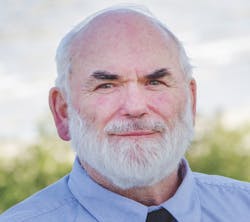About the author:
John Seldon, B.Sc., M.A., has a 48-year wastewater treatment career that includes both the public and private sectors, starting in 1972 with the Ministry of the Environment of Ontario’s research and development division in 1972. Seldon writes and speaks on optimizing dewatering residuals as well as the need for wastewater operators to be certified professional technologists. Seldon can be reached at [email protected].
Tuser: What is the premise of the book?
Seldon: A Water Resource Recovery Facility (WRRF) Superintendent is faced with a murdered body in his primary clarifier. He works with the local police to recover the body, identify it and then help track down the killer. The investigation is led by Officer Klein who enlists his help as she feels his technical knowledge can help her with witnesses and suspects – including all his staff. Both lead characters are single and they develop a relationship during the course of the investigation and their travels to various locations to interview suspects.
Tuser: Describe the inspiration for this particular work.
Seldon: The inspiration came about as an epiphany generated from writing many technical articles which often failed to reach operators as they infrequently had access to the journals for which I wrote. I realized by writing fiction I could communicate with those involved with WRRF’s – from engineers to operators – through more common ground – the murder mystery.
I think “common ground” can be found through members of the water sector (meaning water and wastewater operators) being able to discuss their favorite fictional water sector character. If today you ask a water sector operator who that would be – I don’t believe you would find anyone with an answer. I am trying to provide an answer.
Further, as I write an anthology of personal biographies of operators, water sector operators will be able to name those with whom they most closely identify. Fiction and biography – two sides of the same “common ground” coin.
Tuser: What was your research process like?
Seldon: I accessed my imagination for the plot. I appreciate that may sound elitist or simplistic, but I worked through the plot process organically. However, the technical aspects in the book reflect 45 plus years of work in the wastewater treatment area – my research for that aspect is my experience.
However, for my first sequel, (working title, Aeration Assassination) I will seek a plant where I may research the details their aeration system. Further, I will look to speak with manufacturers about new trends in the aeration process step that may be useful in the plot.
Tuser: What role do you think fiction writing can play in the water sector world?
Seldon: In effect, it seems to me that water sector professionals at all levels have the mechanics of the process in common but that is not enough. Each of these treatment individuals are more than their job position. Writing fiction and other forms of non-technical writing can bring all of these protectors of Public Safety to a broader common ground.
Tuser: What is the key theme and/or message in the book?
Seldon: Wastewater treatment, with water treatment a close second, is a hidden career. This is no small matter considering urban culture cannot survive without first class treatment. On the surface, it is a murder mystery that needs to be solved. On a more subtle level it brings wastewater operators into the world experienced by the rest of society. It is unfortunate perhaps that this is done by a murder but WRRF operators are a key part of the community that no one knows about or thinks about.
Tuser: What do you hope your readers take away from this book?
Seldon: That they feel the read was worth the cost of the book. That the book had value. That they were happy to read a book with their workplace at its core for the first time.
Tuser: What were the key challenges you faced when writing this book?
Seldon: First, being disciplined. You have to keep after a piece of writing – technical or fiction. Next, moving from fact-based writing to fiction. Allowing myself to “make things up” – in short, a plot. Technical writing develops from facts and I am an empiricist. This is a good fit. Fiction however, makes use of facts to supplement a narrative that is by its nature subjective. It is the human condition that is being addressed in my fiction – the motivation for murdering a human being. Facts help get you to a human resolution. Interestingly, this was both challenging and liberating as a writer.
Seldon's book can be found here, on Amazon, and Amazon Canada.
